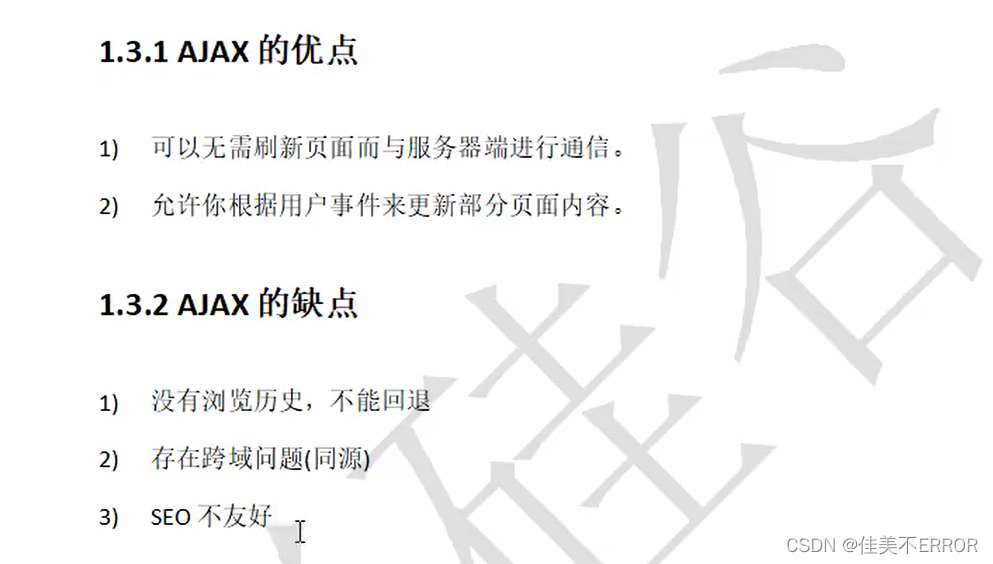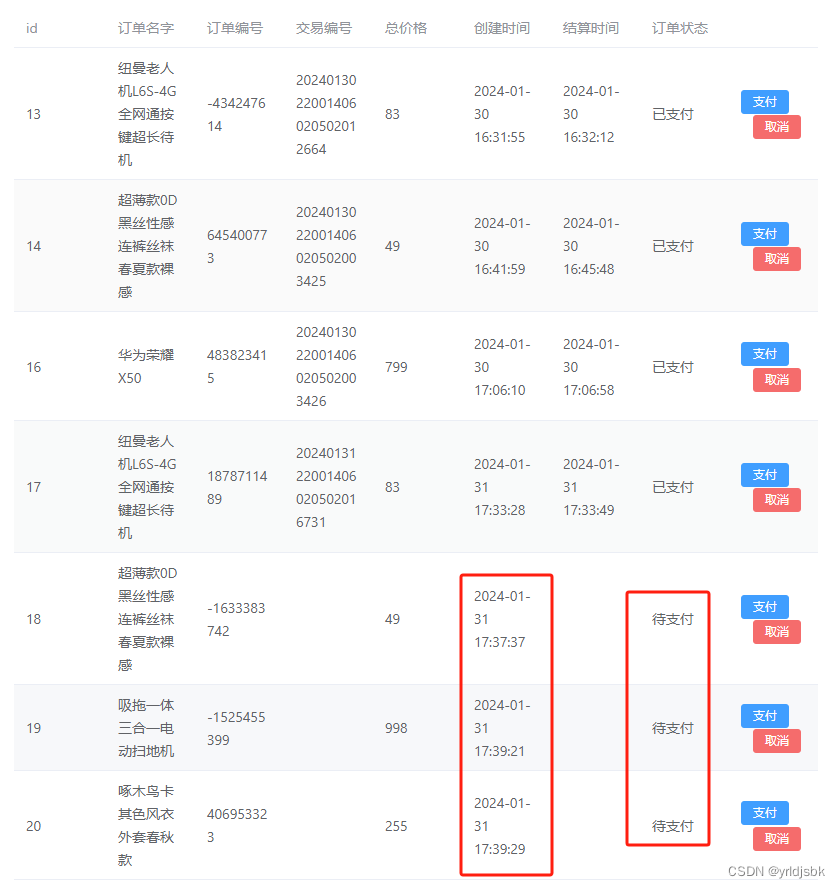AJAX 与Axios
一、案例准备
1、首先数据库必不可少
-- auto-generated definition
create table users
(
id varchar(50) not null
primary key,
name varchar(50) not null comment '姓名',
age int null comment '年龄',
sex int default 1 null comment '性别,1代表男,0代表女默认男,',
password varchar(20) not null,
check (`sex` in (0, 1))
)
charset = utf8;
2、实体类紧跟其后
public class User {
private String id;
private String name;
private String password;
private int age;
private int sex;
}
//此处省略了getter和setter方法以及构造等其他方法
3、然后就是数据库访问层
public class JdbcUtils {
private static final String JDBC_URL = "jdbc:mysql://localhost:3306/test?useSSL=false&serverTimezone=UTC&charsetEncoding=utf-8";
private static final String USERNAME = "root";
private static final String PASSWORD = "root";
private static Connection con = null;
private static Statement stm = null;
private static ResultSet rs = null;
/**
* @return
* 获取连接
*/
public static Connection getCon() {
try {
// 1.注册驱动
Class.forName("com.mysql.cj.jdbc.Driver");
// 2.加载连接
con = DriverManager.getConnection(JDBC_URL, USERNAME, PASSWORD);
} catch (ClassNotFoundException e) {
e.printStackTrace();
} catch (SQLException e) {
e.printStackTrace();
}
return con;
}
/**
* @param sql
* @return
* 公共增删改的方法,因为增删改对行影响,所以返回row
*/
public static int update(String sql) {
int row = 0;
try {
if (con == null) {
con = getCon();
}
stm = con.createStatement();
row = stm.executeUpdate(sql);
} catch (SQLException e) {
e.printStackTrace();
}
return row;
}
/**
* @param sql
* @return
* 查询的方法
*/
public static ResultSet query(String sql) {
try {
if (con == null) {
con = getCon();
}
stm = con.createStatement();
rs = stm.executeQuery(sql);
} catch (SQLException e) {
e.printStackTrace();
}
return rs;
}
/**
*
* @param connection
* @param statement
* @param resultSet
* 关闭连接,释放资源
*/
public static void closeAll(Connection connection, Statement statement, ResultSet resultSet) {
try {
if (connection != null) {
connection.close();
}
if (statement != null) {
statement.close();
}
if (resultSet != null) {
resultSet.close();
}
} catch (SQLException e) {
e.printStackTrace();
}
}
}
public class UserDao {
/**
*
* @param sql
* @return
* 封装的是一个集体查数据的私有方法
*/
private List<User> get(String sql) {
ResultSet resultSet = JdbcUtils.query(sql);
List<User> list = new ArrayList<>();
User user;
try {
while (resultSet.next()) {
user = new User();
user.setId(resultSet.getString("id"));
user.setName(resultSet.getString("name"));
user.setAge(resultSet.getInt("age"));
user.setSex(resultSet.getInt("sex"));
user.setPassword(resultSet.getString("password"));
list.add(user);
}
} catch (SQLException e) {
e.printStackTrace();
} finally {
JdbcUtils.closeAll(null, null, resultSet);
}
return list;
}
/**
*
* @param username 用户名
* @param password 密码
* @return
* 登录方法,简单实现一下,
*/
public boolean login(String username, String password) {
String sql = "SELECT * FROM users WHERE name='" + username + "' AND password='" + password + "'";
List<User> list = get(sql);
if (list == null || list.isEmpty()) {
return false;
}
System.out.println(list);
return true;
}
}
4、直接servlet类
@WebServlet(urlPatterns = "/user")
public class UserController extends HttpServlet {
@Override
protected void doGet(HttpServletRequest request, HttpServletResponse response) throws ServletException, IOException {
String username = request.getParameter("username");
String password = request.getParameter("password");
System.out.println(username + "---doGet---" + password);
UserDao userDao = new UserDao();
boolean login = userDao.login(username, password);
System.out.println(login);
}
@Override
protected void doPost(HttpServletRequest request, HttpServletResponse response) throws ServletException, IOException {
/*
// 字节流,中文乱码
ServletInputStream inputStream = request.getInputStream();
byte[] bytes = new byte[1024];
int len = 0;
String str = null;
while ((len = inputStream.read(bytes)) != -1) {
str = new String(bytes, 0, len);
}
System.out.println("str-----" + str);
// 字符流和字节流获取数据任取一种都可,不过字节流中文乱码,建议使用字符流
*/
/*
// 设置编码
request.setCharacterEncoding("UTF-8");
response.setCharacterEncoding("utf-8");
response.setContentType("text/html; charset=utf-8");
*/
// 使用字符流读取数据
BufferedReader reader = request.getReader();
char[] buf = new char[1024];
int len = 0;
// StringBuilder str = new StringBuilder();
StringBuffer str = new StringBuffer();
while ((len = reader.read(buf)) != -1) {
str.append(buf, 0, len);
}
UserDao userDao = new UserDao();
// 将前端获取到的StringBuffer对象转成String
String s = String.valueOf(str);
System.out.println("str=====" + str+"--------ts====="+s);
// 先判空,在判断是不是JSON格式
if (s != null) {
if (JSONObject.isValid(s)) {
// 转换为JSON格式
JSONObject jsonObject = JSONObject.parseObject(s);
String username = jsonObject.getString("username");
String password = jsonObject.getString("password");
System.out.println(username + "---doPost---" + password);
boolean login = userDao.login(username, password);
System.out.println(login);
}else {
System.out.println("数据格式有问题,用户名密码默认为空");
boolean login = userDao.login(null, null);
System.out.println(login);
}
}
}
}
/*
@Override
protected void doPost(HttpServletRequest request, HttpServletResponse response) throws ServletException, IOException {
// 字节流,中文乱码
ServletInputStream inputStream = request.getInputStream();
byte[] bytes = new byte[1024];
int len = 0;
String str = null;
while ((len = inputStream.read(bytes)) != -1) {
str = new String(bytes, 0, len);
}
System.out.println("str-----" + str);
String[] data = str.split(",");
for (String datum : data) {
System.out.println(datum);
}
}
*/
5、过滤器
@WebFilter(urlPatterns = "/*")
public class EncodingFilter implements Filter {
@Override
public void init(FilterConfig filterConfig) throws ServletException {
}
@Override
public void doFilter(ServletRequest servletRequest, ServletResponse servletResponse, FilterChain filterChain) throws IOException, ServletException {
HttpServletRequest request = (HttpServletRequest) servletRequest;
String method = request.getMethod();
System.out.println(method);
//判断是post方法,设置编码
if ("POST".equals(method)) {
servletRequest.setCharacterEncoding("utf-8");
servletResponse.setContentType("text/html; charset=UTF-8");
}
filterChain.doFilter(servletRequest, servletResponse);
}
@Override
public void destroy() {
}
}
5、注意一点
-
不同点一:
通过get方式提交的数据有大小的限制,通常在1024字节左右。也就是说如果提交的数据很大,用get方法就可需要小心;而post方式没有数据大小的限制,理论上传送多少数据都可以。
-
不同点二:
通过get传递数据,实际上是将传递的数据按照”key,value”的方式跟在URL的后面来达到传送的目的的;而post传递数据是通过http请求的附件进行的,在URL中并没有明文显示。
-
不同点三:
二、原生的ajax请求
1、原生的使用XMLHttpRequest对象获取的异步操作
//发送同步请求
//1.创建ajax引擎对象----所有操作都是由ajax引擎完成
var xmlHttp = new XMLHttpRequest();
//2.为引擎对象绑定监听事件
xmlHttp.onreadystatechange = function() {
//当状态变化时处理的事情
if (xmlHttp.readyState == 4 && xmlHttp.status == 200) {
//5.接收响应信息
var data = xmlHttp.responseText;
//alert(data);
document.getElementById("span2").innerHTML=data;
}
}
//3.绑定服务器地址
//第一个参数:请求方式GET/POST
//第二个参数:后台服务器地址
//第三个参数:是否是异步 true--异步 false--同步
xmlHttp.open("GET", "http://localhost:8099/ajax_demo/user"
false);
//4.发送请求
xmlHttp.send();
// 在JS原生Ajax中,也可以指定 如果是post提交
// 在发送请求之前设置一个头
// xmlhttp.setRequestHeader("Content-type","application/x-www-form-urlencoded");
//xmlHttp.send(data);
2、看原生ajax在实例中用法
<!DOCTYPE html>
<html lang="en">
<head>
<meta charset="UTF-8">
<title>原生ajax(通过XMLHttpRequest对象)登录</title>
<!--
使用原生ajax异步传输数据
-->
</head>
<body>
<div id="loginFrom" style="margin: 20% 30%">
<input type="text" name="username" placeholder="用户名" class="params"><br>
<input type="text" name="password" placeholder="密码" class="params"><br>
<input type="submit" value="get登录" onclick="loginGet()">
<input type="submit" value="post登录" onclick="loginPost()">
<div class="result" width="10px" height="10px"></div>
</div>
<script>
function loginGet() {
let username = document.getElementsByName("username")[0].value;
let password = document.getElementsByName("password")[0].value;
//1.创建ajax引擎对象
let xmlHttpRequest = new XMLHttpRequest();
console.log("-------get====" + "username=" + username + ",password=" + password)
//3.绑定服务器地址
//第一个参数:请求方式GET/POST
//第二个参数:后台服务器地址
//第三个参数:是否是异步 true--异步 false--同步
xmlHttpRequest.open("GET", "http://localhost:8099/ajax_axios_demo/user?username=" + username + "&password=" + password, true);
xmlHttpRequest.send();
//2.为引擎对象绑定监听事件
xmlHttpRequest.onreadystatechange = function () {
//当状态变化时处理
if (xmlHttpRequest.status == 200 && xmlHttpRequest.readyState == 4) {
//接收响应数据
let data = xmlHttpRequest.responseText;
console.log("-----" + data);
} else {
console.log("error!")
}
}
}
function loginPost() {
let username = document.getElementsByName("username")[0].value;
let password = document.getElementsByName("password")[0].value;
//1.创建ajax引擎对象
let xmlHttpRequest = new XMLHttpRequest();
console.log("-------post====" + "username=" + username + ",password=" + password)
//3.绑定服务器地址
//第一个参数:请求方式GET/POST
//第二个参数:后台服务器地址
//第三个参数:是否是异步 true--异步 false--同步
xmlHttpRequest.open("POST", "http://localhost:8099/ajax_axios_demo/user", true);
xmlHttpRequest.setRequestHeader("Content-type", "application/json;charset=utf-8");
//4.发送请求
xmlHttpRequest.send("{'username':'" + username + "','password':'" + password+"'}");
// 在JS原生Ajax中,也可以指定 如果是post提交
// 在发送请求之前设置一个头
//2.为引擎对象绑定监听事件
xmlHttpRequest.onreadystatechange = function () {
//当状态变化时处理
if (xmlHttpRequest.status == 200 && xmlHttpRequest.readyState == 4) {
//接收响应数据
let data = xmlHttpRequest.responseText;
console.log("-----" + data);
} else {
console.log("error!")
}
}
}
function login() {
let username = document.getElementsByName("username")[0].value;
let password = document.getElementsByName("password")[0].value;
//1.创建ajax引擎对象
let xmlHttpRequest = new XMLHttpRequest();
//2.为引擎对象绑定监听事件
xmlHttpRequest.onreadystatechange = function () {
//当状态变化时处理
if (xmlHttpRequest.status == 200 && xmlHttpRequest.readyState == 4) {
//接收响应数据
let data = xmlHttpRequest.responseText;
console.log("-----" + data);
} else {
console.log("error!")
}
}
console.log("-------====" + "username=" + username + ",password=" + password)
xmlHttpRequest.open("GET", "http://localhost:8099/ajax_axios_demo/user?username=" + username + "&password=" + password, true);
xmlHttpRequest.send();
//3.绑定服务器地址
//第一个参数:请求方式GET/POST
//第二个参数:后台服务器地址
//第三个参数:是否是异步 true--异步 false--同步
// xmlHttpRequest.open("POST", "http://localhost:8099/ajax_axios_demo/user?username=admin&password=123456", true);
// xmlHttpRequest.setRequestHeader("Content-type", "application/x-www-form-urlencoded");
//4.发送请求
// xmlHttpRequest.send();
// 在JS原生Ajax中,也可以指定 如果是post提交
// 在发送请求之前设置一个头
}
</script>
</body>
</html>
三、AJAX
1、先导入jQuery.js
<script src="https://unpkg.com/axios/dist/jQuery.min.js"></script>
2、看jQuery封装的ajax在实例中用法
<!DOCTYPE html>
<html lang="en">
<head>
<meta charset="UTF-8">
<title>基于jQuery的ajax登录</title>
<!--
使用jQuery.js封装的ajax
-->
</head>
<body>
<div id="loginFrom" style="margin: 20% 30%">
<input type="text" name="username" placeholder="用户名" class="params"><br>
<input type="text" name="password" placeholder="密码" class="params"><br>
<input type="submit" value="get登录" onclick="loginGet()">
<input type="submit" value="post登录" onclick="loginPost()">
<div class="result" width="10px" height="10px"></div>
<script src="static/jquery-3.6.0.min.js"></script>
<script>
function loginGet() {
let username = document.getElementsByName("username")[0].value;
let password = document.getElementsByName("password")[0].value;
console.log("-------get--------")
$.ajax({
method: 'GET',
// url:'http://localhost:8099/ajax_demo/user?username='+username+'&password='+password,
url: 'http://localhost:8099/ajax_demo/user',
data: {
username: username,
password: password
}
}).then(response => {
console.log(response.data)
}).catch(error => {
console.log(error.data);
});
};
function loginPost() {
let username = document.getElementsByName("username")[0].value;
let password = document.getElementsByName("password")[0].value;
console.log("-------post--------");
$.ajax({
method: 'POST',
url: 'http://localhost:8099/ajax_demo/user',
data: {
username: username,
password: password
}
}).then(response => {
console.log(response.data);
}).catch(error => {
console.log(error.data);
});
}
</script>
</div>
</body>
</html>
四、Axios
1、先导入axios.js
<script src="https://unpkg.com/axios/dist/axios.min.js"></script>
//由于发送的是json字符串,get携带数据使用常规方法接受可以,但post不携带数据,故需用键值对接收
2、看axios在实例中用法
<!DOCTYPE html>
<html lang="en">
<head>
<meta charset="UTF-8">
<title>基于axios登录</title>
<!--
使用axios发送异步请求
-->
</head>
<body>
<div id="loginFrom" style="margin: 20% 30%">
<input type="text" name="username" placeholder="用户名" class="params"><br>
<input type="text" name="password" placeholder="密码" class="params"><br>
<input type="submit" value="get登录" onclick="loginGet()">
<input type="submit" value="post登录" onclick="loginPost()">
<div class="result" width="10px" height="10px"></div>
</div>
<script src="static/axios.js"></script>
<script>
function loginGet() {
let username = document.getElementsByName("username")[0].value;
let password = document.getElementsByName("password")[0].value;
console.log("-------get--------")
axios.get('http://localhost:8099/ajax_axios_demo/user',
{
params: {
username: username,
password: password
},
}).then(response => {
console.log(response.data)
}).catch(error => {
console.log(error.data);
});
}
function loginPost() {
let username = document.getElementsByName("username")[0].value;
let password = document.getElementsByName("password")[0].value;
console.log("-------post--------");
axios({
method: 'post',
// url:'/user',
url: 'http://localhost:8099/ajax_axios_demo/user',
data: {
username: username,
password: password
}
}).then(response => {
console.log(response.data);
}).catch(error => {
console.log(error.data);
});
}
</script>
</body>
</html>
3、基于Vue的axios
<!DOCTYPE html>
<html lang="en">
<head>
<meta http-equiv="Content-Type" content="text/html; charset=utf-8" />
<title>基于Vue的axios登录</title>
<!--
基于Vue的axios异步请求
-->
<script src="static/vue-2.6.14.js"></script>
<!-- <script src="https://cdn.jsdelivr.net/npm/vue@2/dist/vue.js"></script>-->
</head>
<body>
<div id="app">
<div id="loginFrom" style="margin: 20% 30%">
<input v type="text" placeholder="用户名" v-model="username"><br>
<input type="text" placeholder="密码" v-model="password"><br>
<input type="submit" value="get登录" @click="loginGet">
<input type="submit" value="post登录" @click="loginPost">
</div>
</div>
<script src="static/axios.js"></script>
<script>
new Vue({
el: '#app',
data: {
username: '',
password: ''
},
methods: {
loginGet() {
console.log("-------get--------")
axios.get('http://localhost:8099/ajax_axios_demo/user',
{
params: {
username: this.username,
password: this.password
},
}).then(response => {
console.log(response.data)
}).catch(error => {
console.log(error.data);
});
},
loginPost() {
console.log("-------post--------");
axios({
method: 'post',
url: 'http://localhost:8099/ajax_axios_demo/user',
data: {
username: this.username,
password: this.password
}
}).then(response => {
console.log(response.data);
}).catch(error => {
console.log(error.data);
});
}
}
});
</script>
</body>
</html>
原文地址:https://blog.csdn.net/hsp262323/article/details/124280529
本文来自互联网用户投稿,该文观点仅代表作者本人,不代表本站立场。本站仅提供信息存储空间服务,不拥有所有权,不承担相关法律责任。
如若转载,请注明出处:http://www.7code.cn/show_41456.html
如若内容造成侵权/违法违规/事实不符,请联系代码007邮箱:suwngjj01@126.com进行投诉反馈,一经查实,立即删除!
声明:本站所有文章,如无特殊说明或标注,均为本站原创发布。任何个人或组织,在未征得本站同意时,禁止复制、盗用、采集、发布本站内容到任何网站、书籍等各类媒体平台。如若本站内容侵犯了原著者的合法权益,可联系我们进行处理。






